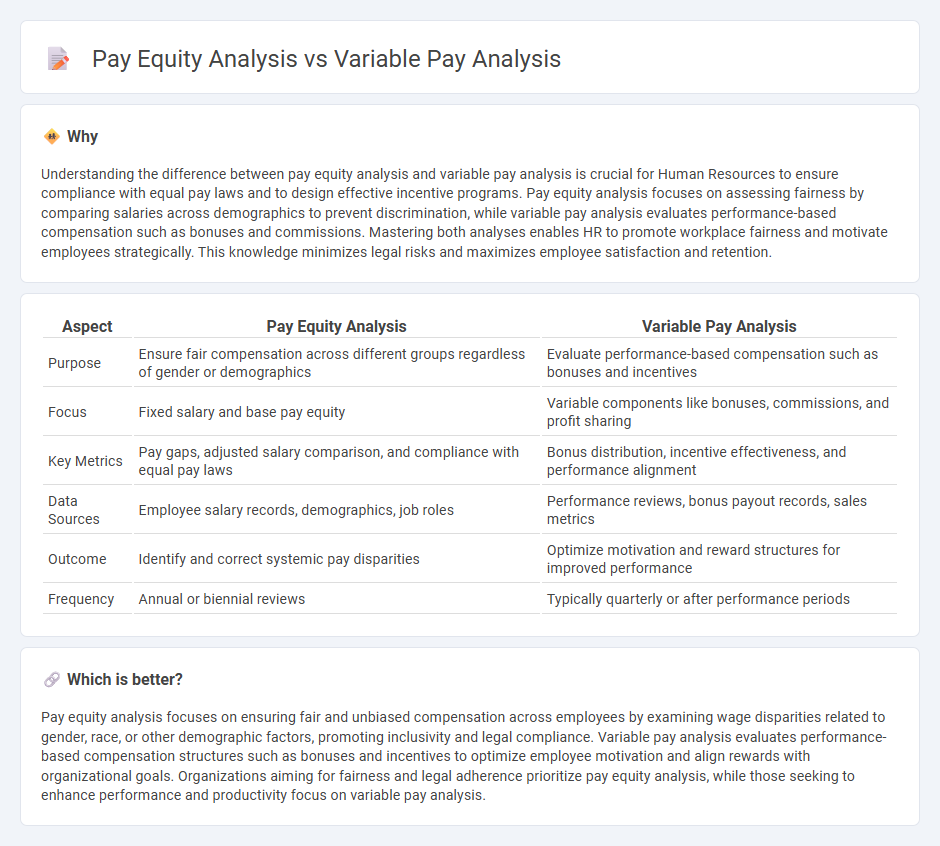
Pay equity analysis ensures fair compensation by examining wage disparities across similar roles to promote equality and compliance with labor laws. Variable pay analysis evaluates performance-based incentives like bonuses and commissions that align employee rewards with organizational goals. Explore the nuances of both approaches to optimize compensation strategies within your company.
Why it is important
Understanding the difference between pay equity analysis and variable pay analysis is crucial for Human Resources to ensure compliance with equal pay laws and to design effective incentive programs. Pay equity analysis focuses on assessing fairness by comparing salaries across demographics to prevent discrimination, while variable pay analysis evaluates performance-based compensation such as bonuses and commissions. Mastering both analyses enables HR to promote workplace fairness and motivate employees strategically. This knowledge minimizes legal risks and maximizes employee satisfaction and retention.
Comparison Table
| Aspect | Pay Equity Analysis | Variable Pay Analysis |
|---|---|---|
| Purpose | Ensure fair compensation across different groups regardless of gender or demographics | Evaluate performance-based compensation such as bonuses and incentives |
| Focus | Fixed salary and base pay equity | Variable components like bonuses, commissions, and profit sharing |
| Key Metrics | Pay gaps, adjusted salary comparison, and compliance with equal pay laws | Bonus distribution, incentive effectiveness, and performance alignment |
| Data Sources | Employee salary records, demographics, job roles | Performance reviews, bonus payout records, sales metrics |
| Outcome | Identify and correct systemic pay disparities | Optimize motivation and reward structures for improved performance |
| Frequency | Annual or biennial reviews | Typically quarterly or after performance periods |
Which is better?
Pay equity analysis focuses on ensuring fair and unbiased compensation across employees by examining wage disparities related to gender, race, or other demographic factors, promoting inclusivity and legal compliance. Variable pay analysis evaluates performance-based compensation structures such as bonuses and incentives to optimize employee motivation and align rewards with organizational goals. Organizations aiming for fairness and legal adherence prioritize pay equity analysis, while those seeking to enhance performance and productivity focus on variable pay analysis.
Connection
Pay equity analysis evaluates compensation fairness across employees by identifying and addressing wage disparities based on gender, race, or other protected characteristics. Variable pay analysis examines performance-based compensation components, such as bonuses and incentives, to ensure they are distributed fairly and align with organizational goals. Integrating both analyses helps human resources maintain equitable total rewards systems and promote workforce motivation.
Key Terms
**Variable pay analysis:**
Variable pay analysis evaluates performance-based compensation components such as bonuses, commissions, and incentives, emphasizing their alignment with individual and organizational goals. It uses metrics like payout frequency, target achievement, and budget adherence to ensure compensation drives desired outcomes. Explore further to understand how variable pay structures enhance employee motivation and business performance.
Incentive Compensation
Variable pay analysis evaluates the effectiveness and alignment of incentive compensation programs with organizational goals, emphasizing performance-based rewards such as bonuses, commissions, and profit-sharing. Pay equity analysis examines whether compensation is fair and unbiased across different employee groups, ensuring compliance with legal standards and promoting workplace diversity and inclusion. Discover more insights on optimizing incentive compensation through comprehensive pay analysis.
Performance Metrics
Variable pay analysis evaluates compensation based on individual or team performance metrics such as sales targets, productivity levels, and achievement of key performance indicators (KPIs), emphasizing motivation and reward for results. Pay equity analysis examines wage disparities across demographic groups, ensuring fair compensation without bias related to gender, ethnicity, or age. Explore more about aligning performance incentives with equitable pay practices to optimize workforce satisfaction and compliance.
Source and External Links
Variable Pay Plans: Definition, Compensation Models, And Examples - This article provides an overview of variable pay, including its definition, structure, and how it is used to motivate employees by linking compensation to performance.
A Comprehensive Guide to Variable Compensation - This guide explains why companies use variable compensation to align employee efforts with company goals and how it can incentivize peak performance and retention.
Variable Compensation: Types & Best Practices for Variable Pay Plans - This resource discusses the pros and cons of variable compensation, including its ability to improve productivity and create a results-oriented culture, while also highlighting potential challenges.
 dowidth.com
dowidth.com